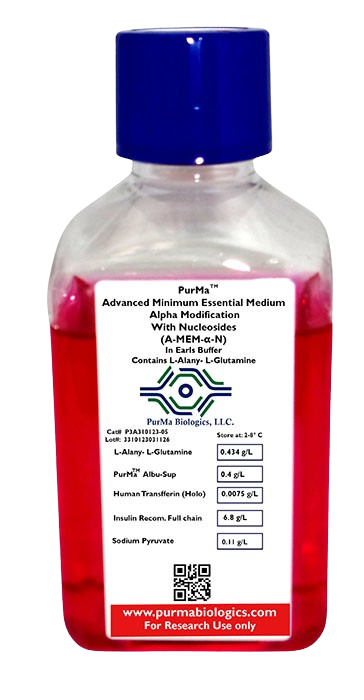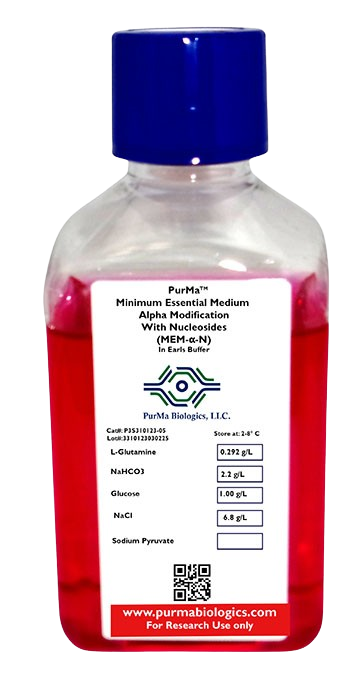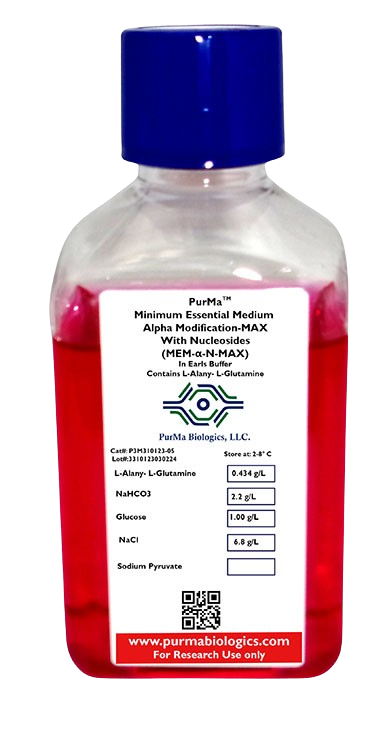MEM Alpha with Nucleosides in Earle’s Buffer (MEM-α-N-EBSS)
Background
MEM Alpha with Nucleosides in Earle’s Buffer (MEM-α-N-EBSS) is a suitable nutrient for mammalian cell culture as well as selection for transfected DHFR-negative cells. This media contains nucleoside, and the formulation is available below. depending on cell types, laboratories use MEM-α-N for growing mammalian cell for a variety of suspension as well as adherent cells. Eliminating calcium in this media facilitates the growth of cells in suspension cultures.
Ingredients
MEM Alpha Modification with Nucleosides in Earle’s Buffer (MEM-α-N-EBSS) is a modification of MEM.
Moreover, MEM-α-N-EBSS contains:
- Non-essential amino acids.
- Sodium pyruvate.
- Lipoic acid.
- Vitamin B12.
- Biotin and,
- Ascorbic acid.
Because PurMa™ MEM-α-N-EBSS includes Earles’ Buffer, it contains:
- Calcium chloride
- Magnesium sulfate
- Potassium chloride
- Sodium bicarbonate
- Sodium chloride
- Sodium Phosphate, monobasic
PurMa™ MEM -α-N-EBSS media also contains:
- Low level of glucose (1.00 g/ liter)
- Sodium bicarbonate (2.2 g/L) (if higher than 5% CO2 is used, a higher % of sodium bicarbonate is needed.
- 2 mM L-glutamine (292 mg/L)’
- PurMa Biologics manufactures 121 types of MEM -α-N-E
The nucleoside modifies this media from MEM-α
it contains:
- Ribonucleosides
- Deoxyribonucleosides
Application
Moreover, this media can also be used for keratinocytes, primary rat astrocytes, as well as human melanoma cells. MEM-α-N-EBSS has also been used for the isolation of mesenchymal stem cells, adipose-derived stem cells, and osteoblasts. Additionally, PurMa™ MEM -α-N-EBSS facilitates the growth and maintenance of primary osteoblast cultures. furthermore, this media performs well for the isolation of polymorphonuclear leukocytes (PMN) from umbilical cord blood.
Formulation
additionally, you can get the complete formulation here”: MEM alpha with Nucleoside Formulation
References
- The growth of L-cells and Vero cells on an autoclavable MEM-peptone medium. Keay, L. Biotechnology and bioengineering, 19(3), 399-411 (1977-03-01).
- Sphingosine-1-phosphate lyase (SGPL1) deficiency is associated with mitochondrial dysfunction. Maharaj et al. The Journal of steroid biochemistry and molecular biology, 202, 105730-105730 (2020-07-20)
-
- MEM Alpha with Nucleosides in Earle’s Buffer (MEM-α-N-EBSS), Cell Culture Media
Advanced MEM-Alpha with Nucleosides in Earle’s Buffer
- Advanced-MEM-Alpha with Nucleosides in Earle’s Buffer (A-MEM-a-N-EBSS) contains L-Alanyl-L-Glutamine as well as ingredients to allow for serum reduction. More importantly, Advanced MEM-α-N needs only 2-5% FBS and provides more consistency.
- Read more
-
- Sale!
- MEM Alpha with Nucleosides in Earle’s Buffer (MEM-α-N-EBSS), Cell Culture Media
MEM Alpha with Nucleosides in Earle’s Buffer (MEM-α-N-EBSS)
- $47.33 – $1077.30
- MEM Alpha with Nucleosides in Earle’s Buffer (MEM-α-N-EBSS) is a suitable nutrient for mammalian cell culture as well as selection for transfected DHFR-negative cells. This media contains nucleoside and, furthermore depending on cell types, laboratories use MEM-α-N for growing mammalian cells.
- Select options
-
- MEM Alpha with Nucleosides in Earle’s Buffer (MEM-α-N-EBSS), Cell Culture Media
MEM α-Modification with Nucleosides MAX in Earle’s Buffer (MEM-α-N-MAX)
- MEM α-Modification with Nucleosides MAX in Earle’s Buffer (MEM-α-N-MAX-EBBS) contains L-Alanyl-L-Glutamine. Additionally, MEM-α-N-MAX (EBBS) significantly improves cell viability and growth. We manufacture several types of MEM-α-N-MAX based on your requirements.
- Read more




